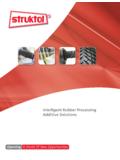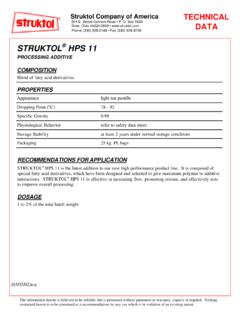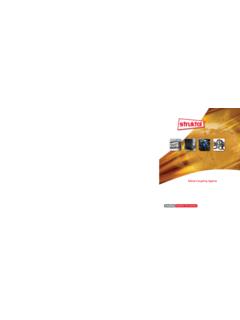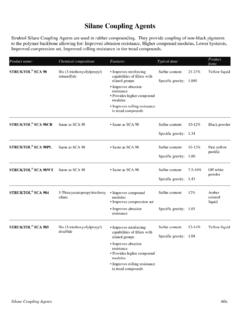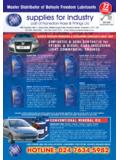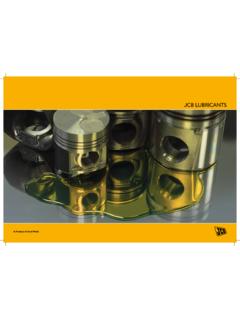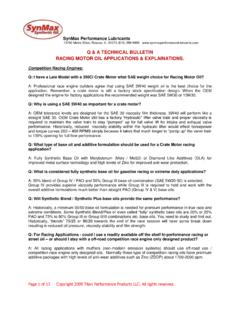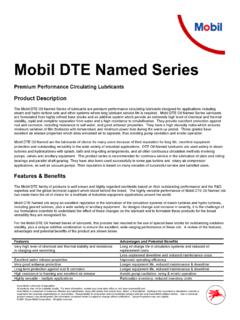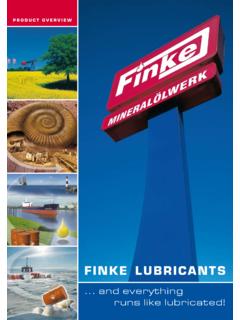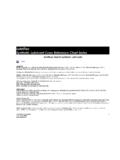Transcription of Lubricants and Additives for Polymer Compounds
1 Introduction to Lubricants and Additives for Polymer CompoundsPresented by Michael S. FulmerOctober 24, 2000 Quality Additives for PerformanceQuality Additives for PerformanceDiscussion of Additives that act as: Lubricants Adhesives SurfactantsWhich function to: Improve dispersion of fillers/pigments Improve processability Improve functionality of the compoundQuality Additives for PerformanceHow, What, Where, Why?Quality Additives for PerformanceTRIBOLOGYThe science and study of the mechanisms of friction, lubricationand wear of interacting surfaces that are in relative :The study of the depressing history of the Cleveland Indians!Quality Additives for PerformanceTRIBOLOGICAL EFFECTORS Lubricants Function to minimize frictional forces between moving surfaces Can be classified as internal, external or both Adhesives Function to increase interfacial forces created by surface attachment ( , mechanical bonding)
2 Increase the energy required to break adhesive bonds causing increased shear Surfactants Create a surface active film via polar and non-polar ends Polar end adsorbs/bonds to a surface Wetting of the filler allows for improved low energy dispersion Lubricant-like end effectQuality Additives for PerformanceLUBRICANTSP olymers are made of long chain molecules of varying sizes and distributions. These polymers tend to be: Relatively viscous above their melt temperature Sticky above their melt temperatureLubricants serve to decrease the frictional forces found between: Polymer : Polymer Polymer : Metal Polymer : Filler Filler : Filler Filler : MetalQuality Additives for PerformanceADHESIVESA dhesive-type Additives are highly branched, relatively low molecular weight, low melt temperature (lower than the Polymer ) materials that disperse within both Polymer and filler.
3 The adhesives will form mechanical bonds with: Polymer : Polymer Polymer : Metal Polymer : Filler Filler : Filler Filler : MetalThe adhesion leads to increased shear forces, required to break the mechanical bonds, increased temperatures, therefore dispersion is Additives for PerformanceSURFACTANTSS urfactants = Surface Active Agents Traditional Head-Tail structure:Tail group is typically soluble in non-polar region (internal).Head group is typically soluble in polar region or adsorbs to surfaces of Polymer , filler or metal. The adsorption is typically via hydrogen bonding. Forms a monolayer with tail group providing lubricating Additives for PerformanceLUBRICANT CLASSIFICATIONT aken from classical PVC terminology: External = Insoluble Typically provide lubrication between the Polymer and the metal surface of the processing equipment Classic types.
4 Polyethylene waxes, Oxidized Polyethylene waxes, Paraffins, Metal Soaps, Esters (high esterification), Amides, Fatty Acids Internal = Semi-Soluble (Plasticizer) Typically reduce bulk viscosity through partial compatibility with the Polymer , thus opening the Polymer chain with the lubricant s soluble component while providing intermolecular lubrication with the less soluble portion of the molecule. Classic types:Fatty alcohols, Esters (low esterification), EVA Wax, othersQuality Additives for PerformanceGENERAL EFFECTS OF Lubricants Internal Lubricants Promote flow Exhibit good clarity Promote weld line strength Minimize sink marks Improve die filling Reduce die swell Reduce head and back pressure Lower HDT External Lubricants Provide metal release Help reduce process temp Can plate out Slow fusion/recrystallization Can cause delamination Can lower weld line strength Can cause surgingQuality Additives for PerformancePOLYMER + FILLER/PIGMENT + LUBRICANT/ADHESIVEQ uality Additives for PerformanceREMEMBER!
5 Most Lubricants provide a combination of internal and external effects. It is the balancing of these effects in the formulation that will determine the ultimate and overall effectiveness of the lubricant!ANDL ubricants will act differently in different Polymer Compounds due to chemical solubility. Thesolubilitieschange relative to Polymer chemistry and other additive (Pigment!) chemistries!Quality Additives for PerformanceGENERAL CHEMISTRIES OF Lubricants Acid Amides Primary Amides: Erucamide, Oleamide, Stearamide Secondary Amides: EBS, EBO Acid Esters PEMS, PEDS, PETS, PEAS, GMS, GMO, Montan Wax,StearylStearate, Distearyl Pthalate Fatty Acids Saturated: Lauric(C12), Myristic (C14), Palmitic (C16), Stearic(C18) Unsaturated: Oleic (C18), Erucic Hydrocarbon Waxes Polyethylene, Polypropylene, OPE, Paraffin Metallic Soaps Calcium, Zinc, Magnesium, Lead, Aluminum, Sodium, Tin, Barium, Cobalt, etc.
6 StearateQuality Additives for PerformanceCHEMICAL STRUCTURE OF Lubricants Acid AmidesCH3-(CH2)7-CH = CH-(CH2)7-CNH2 OOleamideCH3-(CH2)7-CH = CH-(CH2)11-CNH2 OErucamide Acid EstersCH3-(CH2)16-C-O-CH2-(CH2)16CH3 OStearylStearatePEDSOH-CH2 -C-CH2-O-C-(CH2)16CH3OH-CH2 OCH2-O-C-(CH2)16CH3 OQuality Additives for performance Fatty AcidsA large number of Lubricants discussed today are based on a reaction of stearic acid with a metal ion, alcohol or amide. Stearic acid is a long chain fatty acid:CCH3(CH2)16 OOH Metallic SoapsCCH3(CH2)16 OOHZnO +CCH3(CH2)16 OOCCH3(CH2)16 OOZn+ H2 OZinc StearateQuality Additives for PerformanceWHY STEARIC ACID?Most stearic acid is a blend of fatty acids, with the grade determining the stearic (C18) acid volume percent:17212114 Stearic Palmitic5160121192 Rubber Grade6612912 Hydrogenated Tallow4325212 Triple-Pressed43925212 Double-Pressed53825212 Single-Pressed19027 PureOleicArachidicStearicMargaricPalmiti cPentadecanoicMyristicLauricFatty Acid, %POLYMERSQ uality Additives for PerformancePolystyreneCHCH2nCHCH2 PolypropylenenCH3 PolyethyleneCH2CH2nPVCCHCH2nClNylon 6C(CH2)5nONHP olycarbonateCOOOCCH3CH3nQuality Additives for PerformanceWHAT ABOUT COLOR CONCENTRATES?
7 !The selection of Lubricants depends on: Polymer Pigment Chemistries Pigment Levels General Dispersability of the PigmentsThe most common dispersion aids/ Lubricants are: EBS (Acrawax C, Advawax 280, TR-EBS, etc.) Stearates Hydrocarbon waxesQuality Additives for PerformanceWHAT ABOUT COLOR CONCENTRATES?!Goals: Optimum dispersion of the pigment Processability of the concentrate Optimum color development/dispersion in the end use Color stability in the end useFor Lubricants : Aid/improve all of the above Do not interfere with the function of the colorant Examples: Highly acidic lubes degrade Cadmium pigments Zinc stearate yellows Red 2B
